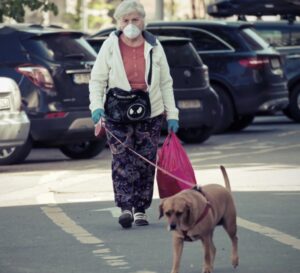As the number of Coronavirus cases continues to spiral across the nation, one recurring message from many public health experts is simple: Wearing masks saves lives. This is one of the most practical ways to protect communities, including our most valued and often vulnerable senior population, until a vaccine is widely available.
 “We are not defenseless against Covid-19,” shares Robert R. Redfield, director of the Centers for Disease Control and Prevention. “Cloth face coverings are one of the most powerful weapons we have to slow and stop the spread of the virus – particularly when used universally within a community setting.”
“We are not defenseless against Covid-19,” shares Robert R. Redfield, director of the Centers for Disease Control and Prevention. “Cloth face coverings are one of the most powerful weapons we have to slow and stop the spread of the virus – particularly when used universally within a community setting.”
A recent study by UCSF researchers found masks may not only prevent spread of the disease, but may reduce the severity of illness. Even if a few viral particles are filtered through a mask, it will likely result in milder symptoms or no symptoms at all, according to researchers. Limited exposure may in fact help the body build immunity and drive the community toward “herd immunity” where there are not enough carriers left to spread the virus.
As face coverings become more commonplace, questions are arising about their efficiency. Which is the best facial covering to slow the spread and which don’t seem to work as well?
In analyzing more than a dozen different facial coverings, researchers at Duke University found a fitted N95 mask, worn most commonly by hospital workers, to be most effective, allowing “no droplets at all” to come out. While it’s not feasible these masks could be made widely available, researchers found cotton cloth masks, ideally with three layers, to be about as effective as standard surgical masks. They agree most masks provide some level of protection. Popular alternatives, such as neck gaiters and bandanas made of thin, stretchy material, provide the least level of protection.
How can you check the effectiveness of your masks?
It is recommended to do a quick home test. Hold the face covering to the light to see if any light comes through and check if you can easily blow through the fabric. If the answer is yes, protection may be limited.
Common mistakes in using face coverings
Proper use and care of face coverings are essential. Common mistakes can compromise the effectiveness of these coverings, including:
- Continually touching the front of your mask which can contaminate the surface and let germs in;
- Masking too late and unmasking too soon by not putting on your mask before you leave to go outside and leaving it on until you return again;
- Sanitizing infrequently and not cleaning your mask after every use and making sure its dry before using it again;
- Taking the mask on and off, such as pulling it below your chin to talk to others;
- Forgetting to social distance while wearing a mask and to maintain at least six feet distance and to avoid crowds for protection; and
- Remembering to wash your hands often and to use sanitizing gel after doing essential activities even while wearing a mask outside. .
Given the ongoing struggle to control COVID-19, most researchers agree the benefits of wearing a mask may well be worth the inconvenience of covering up to protect yourself and others until a vaccine is readily available.



